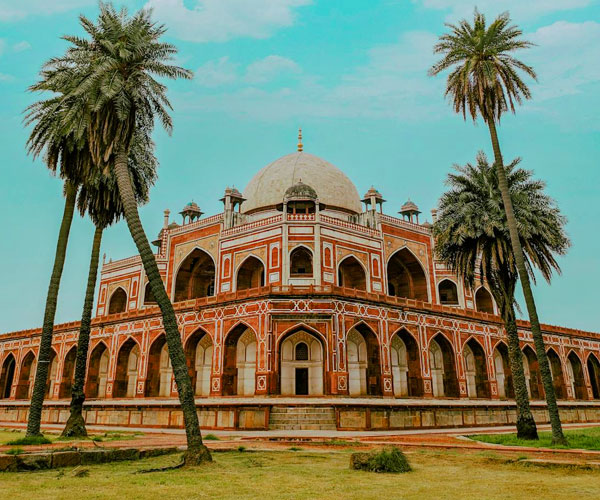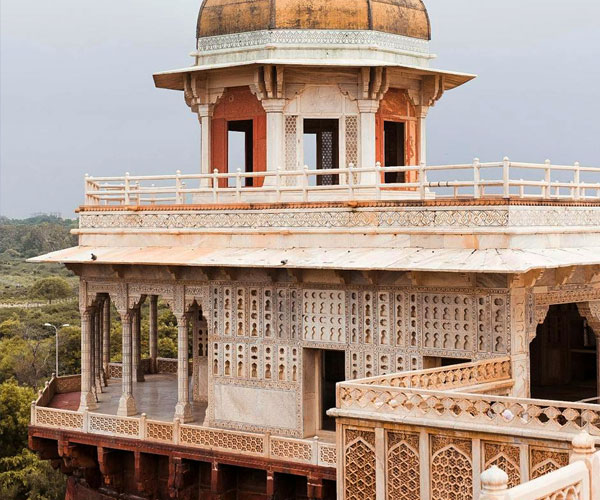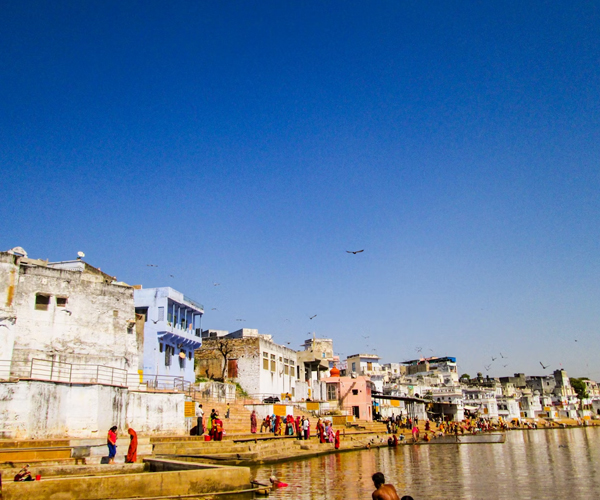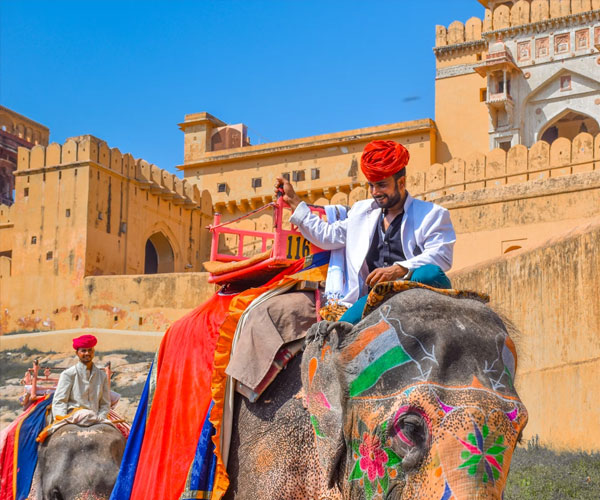




Golden Triangle Tour with Pushkar
- Destinations:- Delhi night 2/ Agra 1 night / jaipur 1 night / pushkar 2 night
- 7 Days - 6 Nights
The Golden Triangle Tour serves as a quintessential introduction to India, encompassing three culturally and historically rich cities: Delhi, Agra, and Jaipur. This itinerary is enhanced by the inclusion of Pushkar, a revered pilgrimage town renowned for its sacred lake and vibrant camel fair. This curated journey offers travelers a harmonious blend of architectural grandeur, spiritual serenity, and vibrant local culture—an experience destined to create lasting memories.
Visit Delhi’s iconic sites: Qutub Minar, India Gate, and Humayun’s Tomb
Marvel at the stunning Taj Mahal and historic Agra Fort
Explore Jaipur’s royal Amber Fort, Hawa Mahal, and City Palace
Experience the spiritual charm of Pushkar Lake and the Brahma Temple
Wander through vibrant markets and soak in local culture across all cities
Day 1: Arrival in Delhi
Upon arrival at Indira Gandhi International Airport, Delhi, you will be greeted by our representative who will provide assistance with your transfer to the hotel. After completing check-in formalities, spend the remainder of the day at leisure, unwinding after your journey.
Explore key landmarks at your own pace:
Lotus Temple – A symbol of peace and unity, this Bahá'í House of Worship is celebrated for its striking lotus-shaped architecture and tranquil ambience.India Gate – A majestic war memorial dedicated to Indian soldiers who lost their lives in World War I and the Indo-Afghan conflict. Gurudwara Bangla Sahib – A prominent Sikh temple known for its spiritual aura, sacred sarovar (pond), and the tradition of serving free meals through its community kitchen (Langar). Old Delhi – Discover the charm of historic lanes, bustling bazaars, and architectural marvels that echo the city’s Mughal past.
Overnight stay at the hotel in Delhi.
Day 2: Full-Day Delhi Sightseeing
After a wholesome breakfast, embark on a guided tour of Delhi’s key historical and cultural sites:
Raj Ghat – A serene black marble platform marking the cremation site of Mahatma Gandhi, the Father of the Nation. Humayun’s Tomb – An exquisite example of Mughal garden-tomb architecture, commissioned by Empress Bega Begum in memory of her husband, Emperor Humayun.
Lodhi Garden – A lush heritage park housing architectural relics from the Lodhi and Sayyid dynasties, including the Tombs of Sikandar Lodi and Mohammed Shah, along with grand domed pavilions. Qutub Minar – The tallest brick minaret in the world and a UNESCO World Heritage Site, built in the early 13th century. Parliament House & Rashtrapati Bhavan (Drive-pass) – View the seat of India’s democracy and the official residence of the President of India. Akshardham Temple – A masterpiece of intricate artistry, showcasing India’s rich spiritual heritage through breathtaking sculptures, exhibitions, and musical fountain shows.
The evening is free for exploring local markets, where you may shop for handcrafted souvenirs and traditional Indian textiles. Overnight stay at the hotel in Delhi.
Day 3: Delhi – Agra Through Yamuna Express way
Embark on an early morning excursion to Agra. Upon arrival, check in at the pre-booked hotel and take some time to relax. Later, proceed for a guided sightseeing tour of Agra, covering some of the city’s most renowned attractions. Begin with a visit to the Agra Fort, a UNESCO World Heritage Site. Situated on the right bank of the Yamuna River, this grand red sandstone fortress once served as the main residence of the Mughal emperors. The fort complex houses several impressive structures, including the Jahangiri Mahal, Diwan-i-Khas, Diwan-i-Aam, and the Musamman Burj, where Shah Jahan was imprisoned during his final years. Next, explore the Tomb of I'timād-ud-Daulah, popularly known as the Baby Taj. Often regarded as a draft of the Taj Mahal, this exquisite marble mausoleum was commissioned by Nur Jahan in memory of her father, Mirza Ghiyas Beg. The monument is admired for its intricate inlay work and delicate lattice screens, showcasing early examples of the pietra dura technique.Continue to Mehtab Bagh, a charbagh-style garden complex located on the opposite bank of the Yamuna River. This serene garden offers one of the most stunning views of the Taj Mahal, especially at sunset, when the white marble monument is bathed in golden hues. Overnight stay at the hotel in agra .
Day 4: Agra – Fatehpur Sikri – Chand Baori – Jaipur
Begin your day early with a visit to the most iconic monument in the world – the Taj Mahal – renowned for its breathtaking beauty at sunrise. As the first rays of the sun gently illuminate the pristine white marble, the monument glows with a soft pinkish hue. The embedded semi-precious gemstones sparkle in the morning light, while the serene melody of birdsong enhances the tranquil ambiance. Commissioned in 1632 by the Mughal Emperor Shah Jahan in memory of his beloved wife Mumtaz Mahal, the Taj Mahal stands as an eternal symbol of love. This architectural masterpiece is an exquisite blend of Persian, Islamic, and Indian styles, featuring intricate pietra dura inlay work, symmetrical gardens, and a reflecting pool that mirrors the monument’s majestic dome.
Following breakfast, proceed to Jaipur by road. En route, visit Fatehpur Sikri, the former capital of the Mughal Empire, now a designated UNESCO World Heritage Site. Founded by Emperor Akbar in the 16th century, this historic city is renowned for its exceptional architectural harmony, combining elements of Persian, Islamic, and Indian styles. Prominent monuments within the complex include the Buland Darwaza, one of the tallest gateways in the world; Jodha Bai’s Palace, notable for its blend of Rajput and Mughal design; and the Panch Mahal, a five-storey structure built for leisure and royal women, offering a unique view of the surrounding area.
Continue the journey with a visit to Chand Baori, located in the village of Abhaneri. Dating back to the 8th or 9th century, Chand Baori is among the deepest and most visually striking stepwells in India. It is acclaimed for its symmetrical design and remarkable engineering, featuring 3,500 precisely arranged steps descending over 13 levels. The site stands as a testament to the ingenuity of ancient water conservation methods in arid regions.
Upon arrival in Jaipur, check in at your hotel and spend the remainder of the day at leisure to rest and rejuvenate.
Day -5 Jaipur Local Sightseeing
Begin your day with a wholesome breakfast at the hotel. Afterward, embark on a guided sightseeing tour of Jaipur, the capital of Rajasthan, often referred to as the Pink City due to its distinctive rose-colored architecture. Your exploration starts with a visit to the magnificent Amber Fort, located on the outskirts of the city. Perched atop a hill, this 16th-century fort was built by Raja Man Singh and is known for its artistic blend of Hindu and Mughal architecture. The fort complex includes impressive structures such as the Sheesh Mahal (Mirror Palace), Diwan-i-Aam (Hall of Public Audience), and Ganesh Pol (ornate gateway), all set against the backdrop of rugged hills and the Maota Lake. Continue to the iconic Hawa Mahal, or Palace of Winds, a five-storey pink sandstone structure featuring 953 intricately latticed windows, known as jharokhas. These were designed to allow royal ladies to observe street festivities while remaining unseen, in accordance with the customs of the time. Next, visit the City Palace, a grand complex of courtyards, gardens, and buildings that served as the seat of the Maharaja of Jaipur. A unique fusion of Rajasthani and Mughal architectural styles, the palace houses several museums showcasing royal costumes, weapons, and artifacts. Proceed to the Jantar Mantar, an 18th-century astronomical observatory built by Maharaja Sawai Jai Singh II. This UNESCO World Heritage Site features a collection of large stone instruments designed to measure time, predict eclipses, and track celestial bodies with remarkable precision. En route, stop at Jal Mahal, or Water Palace, located in the middle of the Man Sagar Lake. Originally used as a lodge for royal duck-shooting parties, the beautifully symmetrical structure appears to float on the tranquil waters, offering a picturesque view, especially during sunset. Conclude your sightseeing with a visit to the Nahargarh Fort, strategically perched on the Aravalli Hills. The fort offers panoramic views of the cityscape and is steeped in legend, with tales of a restless spirit said to have once haunted its construction, adding a touch of intrigue to its history.
Return to your hotel in the evening to relax. Overnight stay in Jaipur.
Day 6: Pushkar Sightseeing and Camel Safari
After breakfast, proceed for a guided sightseeing tour of Pushkar, one of the holiest towns in India, known for its spiritual significance and cultural heritage. Begin your tour with a visit to the Pushkar Lake, a revered pilgrimage site surrounded by over 50 bathing ghats and numerous temples. According to Hindu mythology, the lake was formed when a lotus flower dropped from the hands of Lord Brahma, making it one of the most sacred lakes in India Next, visit the Apteshwar Temple, a tranquil shrine dedicated to Lord Shiva, offering a serene atmosphere ideal for reflection and spiritual connection.
Continue to the Varaha Temple, one of the oldest temples in Pushkar, dedicated to Lord Vishnu in his boar incarnation. The temple is noted for its intricate stone carvings, elaborate pillars, and ancient sculptures that reflect traditional Rajasthani temple architecture. Proceed to the Brahma Temple, one of the very few temples in the world dedicated to Lord Brahma, the creator in the Hindu trinity. This sacred temple is of great religious importance and features a distinctive red spire and a silver turtle embedded in the floor of the sanctum. In the late afternoon, enjoy a camel safari across the desert terrain surrounding Pushkar. The safari culminates with a spectacular sunset view from the sand dunes near Savitri Mata Temple Hill or the outskirts of Ganahera village, located on the western edge of the town. These elevated vantage points offer expansive desert views, making them ideal for witnessing the stunning transition of the sky into warm hues of orange and gold as the sun sets behind the Aravalli hills. If visiting in November, you will have the unique opportunity to experience the vibrant Pushkar Fair. This world-renowned cultural event is one of the largest livestock fairs in India and also features folk performances, camel races, traditional markets, and competitions, attracting thousands of tourists and devotees from across the globe. Return to the hotel in the evening for an overnight stay in Pushkar.
Day 7: Pushkar – Delhi (By Road)
After breakfast, check out from the hotel and begin your return journey to Delhi by private vehicle. Sit back and enjoy a comfortable drive through the changing landscapes of Rajasthan and Haryana.
Upon arrival in Delhi, you will be transferred to the Indira Gandhi International Airport to board your onward flight to your next destination, carrying with you the cherished memories of a culturally rich and unforgettable journey through North India.
End of Tour.
Note:
If you plan your trip in October or November, don’t miss the Pushkar Camel Fair, a once-a-year cultural extravaganza that adds a colorful dimension to your journey.
Inclusions
✔ Private, uniformed chauffeur
✔ Live tour guide fluent in multiple foreign languages
✔ Monument entry fees (if selected option)
✔ Sightseeing by air-conditioned private car or tempo traveller
✔ Pickup and drop-off at Delhi Airport, railway station, or preferred location
✔ All parking fees, tolls, fuel, interstate taxes, and driver allowances covered
✔ 3-star or 5-star hotel accommodation with breakfast (if selected option)
Exclusions
❌ Personal expenses not specified in the package
❌ Any activities not listed under inclusions.
